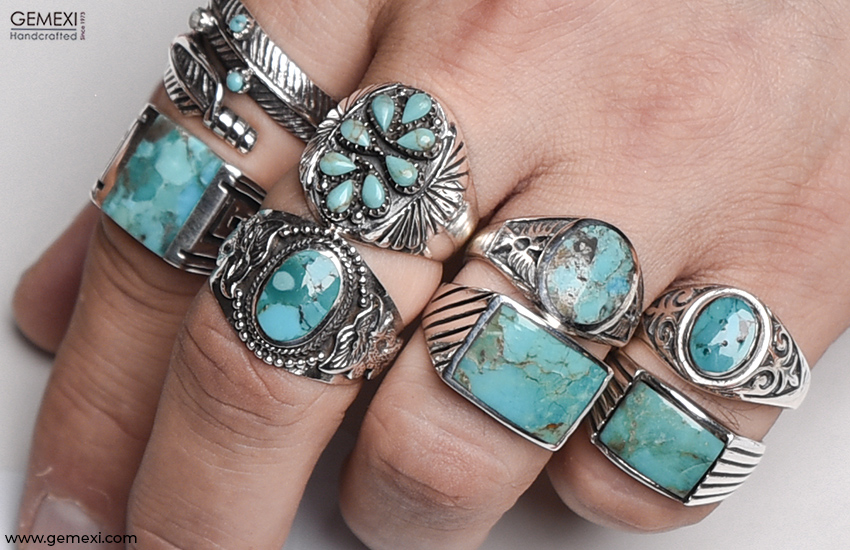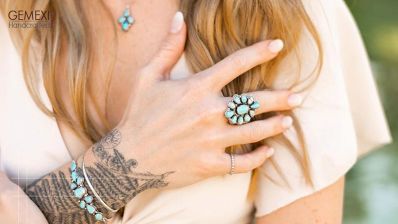Grading Turquoise Color: Understanding the Value of Different Shades
By Gemexi Team | Turquoise- Updated On Jul 7, 2023

Turquoise, with its vibrant hues ranging from sky blue to green, is a highly sought-after gemstone known for its beauty and cultural significance. One of the key factors that determine the value of turquoise is its color. The color of turquoise can vary greatly, and understanding the grading system can help you discern the quality and worth of the stone. In this blog, we will explore the grading of turquoise color in detail and shed light on which colors are considered more valuable in the market.
Turquoise Color Grading System:
The color grading system for turquoise is subjective and can vary among different experts and dealers. However, there are some general guidelines used to assess the color of turquoise. The grading system typically considers three main aspects of the stone's color:
- Hue: The hue refers to the dominant color of the turquoise. It can range from blue to green, with variations in intensity. Pure blue and pure green are considered the most desirable hues. Some rare turquoise may also exhibit a mix of blue and green, creating a unique and prized hue.
- Saturation: Saturation refers to the intensity or richness of the color. Turquoise with high saturation appears vivid and intense, while lower saturation can result in a more muted or pale appearance. Stones with high saturation are generally more valuable as they exhibit a bold and eye-catching color.
- Tone: Tone refers to the lightness or darkness of the color. It is often described as a scale ranging from light to dark. The ideal tone for turquoise is medium to medium-dark, as it allows the color to be visible without appearing too light or too dark.
Grading Turquoise Color:
Turquoise color grading is typically divided into several categories to assess the quality and value of the stone. Let's explore these categories in detail:
- AAA: This is the highest grade of turquoise color and represents stones with exceptional hue, saturation, and tone. AAA turquoise is characterized by vibrant blue or green color, intense saturation, and medium to medium-dark tone. These stones are considered rare and highly valuable.
- AA: AA grade turquoise exhibits a good color range with strong hues and saturation. The tone of AA turquoise can vary, but it generally falls within the medium to medium-dark range. These stones are also highly desirable and valuable.
- A: A grade turquoise represents stones with a moderate color range and lower saturation compared to AAA and AA grades. The hue may be slightly less vibrant, and the tone can vary from light to medium-dark. While A grade turquoise is still considered valuable, it is usually priced lower than higher-grade stones.
- B: B grade turquoise exhibits a wider range of color variations, with hues that may be less vibrant and saturation that is not as strong as higher grades. The tone can range from light to medium-dark. B grade turquoise is often more affordable but can still display beautiful color characteristics.
Worth of Turquoise Colors:
When it comes to determining which color of turquoise is worth more, there are a few factors to consider. The rarity of the color, intensity of saturation, and desirability among buyers play significant roles in determining the value of turquoise. In general, the following colors are considered more valuable in the market:


- Intense Blue: Turquoise with a vivid and pure blue color, high saturation, and medium to medium-dark tone is highly prized. This color is often associated with classic Southwestern turquoise and is considered a symbol of high-quality stones.
- Intense Green: Turquoise with a vibrant and pure green color, intense saturation, and medium to medium-dark tone is also highly sought after. Green turquoise is less common than blue turquoise, making it more valuable and desirable.
- Robins Egg Blue: This light and bright blue color, reminiscent of the sky on a clear day, is favored by many collectors. Turquoise with a clear, pastel blue hue and moderate saturation can command higher prices in the market.
It's important to note that personal preferences and cultural significance can also influence the perceived value of turquoise colors. Some individuals may have a particular affinity for certain shades or variations of turquoise, which can drive up their value.
In conclusion, the color of turquoise plays a significant role in determining its value. The hue, saturation, and tone of the stone contribute to its overall beauty and desirability. While intense blue and green colors are generally considered more valuable, every shade of turquoise carries its own unique charm and appeal. Ultimately, the worth of turquoise color is subjective, and it's important to choose a stone that resonates with your personal taste and style.
In conclusion, the color of turquoise plays a significant role in determining its value. The hue, saturation, and tone of the stone contribute to its overall beauty and desirability. While intense blue and green colors are generally considered more valuable, every shade of turquoise carries its own unique charm and appeal. Ultimately, the worth of turquoise color is subjective, and it's important to choose a stone that resonates with your personal taste and style.
- Tags:
- Turquoise










0 Comments
Write Comments